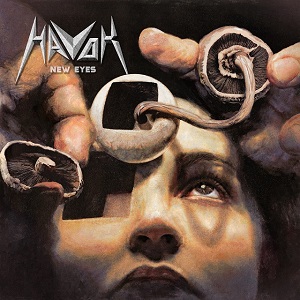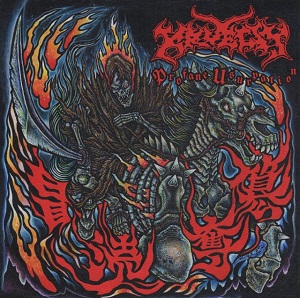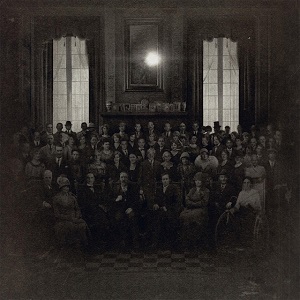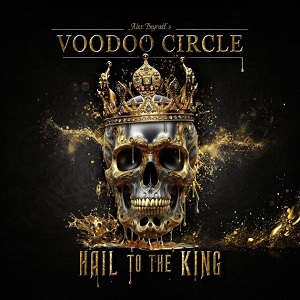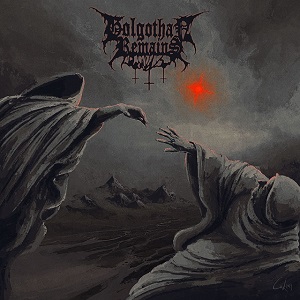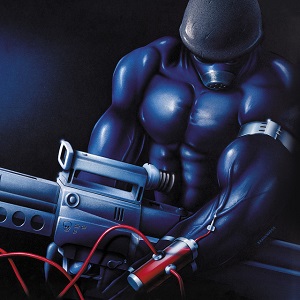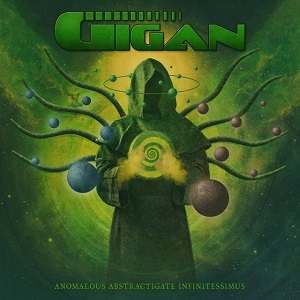MYLES KENNEDY – “What Dark Possibilities Lie Around The Corner”
May 13, 2021, 3 years ago
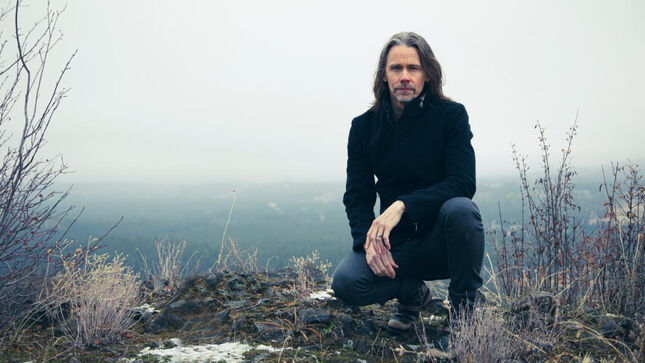
The Ides Of March is the second solo album from singer / songwriter Myles Kennedy. It’s certainly different from Alter Bridge and Slash Featuring Myles Kennedy And The Conspirators, his two main outfits. It’s also quite the contrast from Kennedy’s first solo record, Year Of The Tiger. Released in 2018, Year Of The Tiger was primarily acoustic in nature, and on The Ides Of March, Myles is exploring Memphis Delta-soaked blues, using slide guitar and lap steel to the fullest of their potential.
“This was a record that I kind of started thinking about making about three years ago, as far as the textures and the instrumentation, especially when I was out promoting Year Of The Tiger,” begins Myles. “We were having to take a lot of those acoustic arrangements and translate them in more of a live realm; essentially, I was plugging in more. The versions were a little more amplified. I thought, this is really fun! I’m enjoying this, it’s allowing me to stretch out and play more lead guitar. I wanted to take that into consideration, putting these arrangements together. So, along with that, was also the opportunity to explore more slide guitar, more of the things I started with Year Of The Tiger, as far as the lap steel.”
“I really became a big fan of the lap steel through that process. When I went in to play those sessions, it was Elvis’ idea, my producer (Michael “Elvis” Baskette). He said, ‘What do you think of putting lap steel on some of these tracks?’ I was like, ‘Yeah, great. Who can we find to do that?’ He had a lap steel in the corner, and I said, ‘Tell you what, let me give it a shot and see what happens.’ It was kind of trial by fire. I had to learn as we were going. What I found was, I viewed it like I would view a guitar neck and managed to somehow keep my head afloat. What I discovered is just what an expressive instrument it is. It’s such a haunting instrument. You can emote in a way that you can’t do on other instruments. I became very… I won’t say obsessed, but pretty close to being obsessed with the lap steel.”
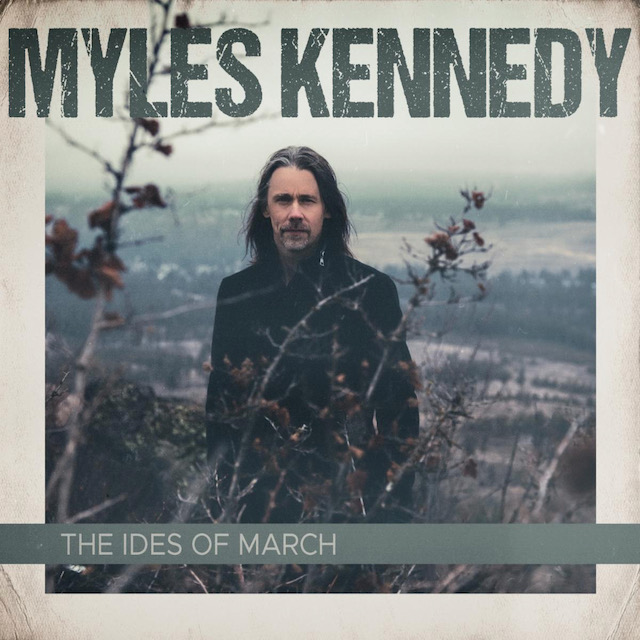
The title of the album, The Ides Of March, carries some significance. If anyone was paying attention during history class at school, The Ides Of March is the day Roman dictator Julius Caesar was assassinated in 44 BC. “Right,” chuckles Myles. “It definitely has some weight. It was funny cause a fair amount of people have said, ‘Why didn’t you release the record in the middle of March, instead of the middle of May?’ We didn’t think about that. The Ides Of March – it would have been perfect. But it was too late. We had to set the record up and put it in the proper channels and do it correctly. As far as what it means to me, that phrase, ‘Beware The Ides Of March’, is prophetic. It’s the idea of what dark possibilities lie around the corner.”
“When I was writing the majority of these songs, it was the beginning of the world shutting down; there was so much uncertainty. I felt like that phrase really summed up, at least for me, the idea of taking what was happening seriously, and not to minimize it and look at it through that lens. It was funny, once the song was complete, I realized that it was certainly going to be an important part of the record. I was really happy once it was all said and done, but it took a good six months to finish that track. It was a labor of love. Whereas other tracks came very quickly. ‘Moonshot’ was written in two hours and demoed in an afternoon. That’s the funny thing about songwriting, you never know how each track will ultimately be completed. ‘The Ides Of March’ was an arduous process.”
In all fairness, at seven and a half minutes, “The Ides Of March” is the longest song on the album, and it also has some Latin vibes to it, which is a departure from the blues base that predominates the rest of the record. “Yeah, that’s a good point,” concurs Kennedy. “I think some of that is because I was informed, stylistically, by waking up and coming out of a dream. The lyric wasn’t in place yet, but I heard the melody. I thought, hmm, that’s interesting. I can lay here and stare at the ceiling for the next half hour, or I can get up and record that onto my phone, and maybe it’ll turn into something. So, I did that, and I came up with what would be the chorus in that same little sitting, probably half an hour after waking up. I let it percolate. It was something that… I had that piece, then I came back and revisited it a few months later. I had the introduction that ended up coming into the fold. When it was all said and done, I felt like it was still congruent enough with the rest of the record; cause you bring up a very valid point – it definitely has this Latin vibe to it. I wanted to make sure that when I played the guitar solo that I incorporated more of the bluesy element to tie it all together.”
The aforementioned “Moonshot” certainly seems to deal with the pandemic as its lyrics read, in part: “Over and over again we took so much for granted, still we refuse to give in to the fate we’ve been handed.” And that’s followed by: “There’s no purpose, there’s no plan, but I don’t care or give a damn as long as you’re okay.” “Yeah, it was definitely inspired by what was happening. That was one of the first tracks, of what I like to refer to as quarantunes,” laughs Myles. “When everything was shutting down, once again, it was all that uncertainty. But it really became obvious to me, once I couldn’t tour anymore and play, just how much of that I personally took for granted. That song, in the first line, ‘I remember when we were suiting up again before the end of time.’ I was envisioning standing in front of my wardrobe case with the other guys in the band, getting ready to go do a show. We just took all of that for granted. That was just the way it was going to be. We were going to continue to get to experience that night after night. We were in the middle of a tour cycle, but then all of a sudden, the world shut down. I think this song definitely explores those emotions.”
“Wake Me When It’s Over” has a very similar theme as that song title is a phrase everyone can relate to during the COVID-19 crisis. It also features timely lyrics: “What comes next? Well, I must confess, I haven’t got a clue. For all I know, the end is coming soon.” “Once again it was just that uncertainty; you didn’t know what was just around the corner. In my lifetime, I’ve never experienced… I guess we’re kind of all in the same boat there. This thing suddenly changes our day-to-day existence on a profound level, and you really don’t know how to navigate through these new, treacherous waters. Songs like that were really just my way of trying to deal with it and reflect on it. It’s nice to hear when people like yourself hear the songs and those lyrics jump out, and it has the same meaning. That means my need to work through it and make sense of things is hopefully translating to the listener, and in listening, it’ll do the same thing for them.”
Myles’ positive take on this disastrous situation should be applauded, as so many people are negative and miserable. Yet he’s come up with these beautiful songs about a horrendous period in our lives. All eleven tracks are enjoyable, heartfelt listens that will stand the test of time. They won’t be relegated to “pandemic songs”; in 2026 The Ides Of March will still be vital. “That’s really a relief to hear, cause that was one of my concerns,” admits Kennedy. “Because of the themes of these songs, it might have a finite shelf life. But as a writer, I guess what I’ve learned to do over the years, is tell stories in an ambiguous enough way where they can have dual meanings, and they can apply to different scenarios. Don’t be too direct, because when a song has been released, people can kind of gauge, just given a few key lines, what this might be inspired by. But my hope is the songs will age in a fashion that won’t allow the shelf life to expire.”
“Get Along” is a perfect example of double meanings. Upon the first few listens, the song seemed to be about racism and political divide in The United States. Once the animated video was released, it’s apparent the song is about how society is essentially destroying the animal kingdom. “It’s great to hear. Once again, I try to keep it ambiguous enough to have… not a number of meanings, but I want it to be something that the listener could instill their own narrative to it, to a point. It was actually inspired, initially for me, by the riots in 1992 in Los Angeles. ‘I still remember just like it was yesterday, the moment the gavel brought the fires and the rage.’ It was the Rodney King riots. Keep in mind, this was written in March of last year, so this was before George Floyd and everything that happened in the summer. But once again, that was the jumping off point for me, then I wanted it to be broader. When it gets to those pre-choruses, I wanted to veer off into a little broader context, but still signifying the need for tolerance and unity. Then the video, you bring that into the fold, and it forms the narrative in a different way. As you can tell, I’m a big fan of having these dualities within the context of the lyrics.”
The animated videos for “Get Along” and “In Stride” are entertaining, as well as offering something different. There’s only so many ways you can film a guy playing guitar. “Right,” agrees Myles. Was this format utilized because of the pandemic, and ensuing difficulty with safely filming a traditional rock video. “Yeah, it was tricky. Kind of all of the above, really. The idea that, how many times can you do just a straight-up live video, and keep it interesting? Also, given the fact that we were in the middle of these unprecedented times, it was difficult to get everybody in the same room together. And, the biggest thing is, we were fortunate enough to work with these really great directors who would take the genesis of our vision; my manager Tim and I, would riff and try and come up with ideas for some of these videos. Then you hand them over to the director and the animator, and they go to the next level. That is definitely a very, very important part of the equation. When you have directors and animators who are as talented as these guys are, and they can move the vision into this realm that you could not have imagined yourself, you want to take advantage of that.”
Tim Tournier is not only Myles’ manager, he’s also his bass player. “Correct. He’s a true renaissance man, jack of all trades.” Just like he did for Year Of The Tiger, Myles got in the car and drove from Washington State to Florida, so he could record The Ides Of March with producer Michael “Elvis” Baskette. “Yeah, it’s pretty crazy. By around June (of 2000) or so, I knew we were supposed to go in the studio in August, but I started to get cold feet cause I wasn’t sure if I wanted to fly. I didn’t know how safe everything was. And once again, there was just so many questions. There were so many things at that point that we didn’t know and understand. So, Elvis and Tim talked, and they brought up the idea – ‘How about if you just drive across the country? Rent an SUV of some sort and have a road trip.’ I’m actually glad we did it that way cause Zia Uddin, my drummer, who I’ve known since 1985, maybe even ’84; we were kids together, and we played in bands together. So, there’s a long history there. It was great to get in the vehicle with him. We just started driving, then we met Tim in Tennessee, halfway through the journey. It was a fun trip! We knocked it out in three days, driving fourteen hours a day, and made it to Orlando. Then, we all stayed in the same house, didn’t leave. The studio’s connected to the house, and we just worked away for a good month or so. In fact, the entire trip, I don’t think we even turned the radio on, or podcasts, anything. We literally were just goofing off, telling old stories, laughing and acting like three teenagers; it was wonderful!”
Seeing as The Ides Of March is the second solo album from Myles Kennedy, it would be expected that the studio experience was easier this time around. “Yeah, I think it was less stressful because we’d done it before, and everybody involved was comfortable with each other. On the first record, we were all just kind of trying to figure things out; it was the first time we played together as a unit, and it was my first official solo record. One of the biggest differences, from my perspective, was that I had so much time to work on demos, cause I was in the middle of a lockdown and couldn’t tour. I’d get up everyday for six months and chip away at putting the arrangements together of these songs, versus Year Of The Tiger, where all I did was send demos of acoustic guitar and vocals; then we built the arrangements when we got in the studio. For me, it put my mind at ease, knowing that I’d fleshed out the arrangements beforehand on this record. Everything was pretty much ready to go in that respect. We changed a few things, but that helped me rest easy because I felt like the vision was solidified. And by the time we got into the studio, it was really just a matter of re-recording the demos; sonically getting things to sound much better than I could do at my home studio; and take the songs to the next level that way.”
“Worried Mind” is such a terrific song, it’s the perfect closing track for The Ides Of March. “Thank you. I think the genesis of that song might have been born during the Year Of The Tiger period. It’s just a real simple blues chord progression, with a substitution or two. I didn’t really have anything else, a little bit of a melody. I had the Worried Mind phrase, but I didn’t have a home for it. I didn’t feel like it would fit in the Year Of The Tiger narrative. It seemed like something worth revisiting for this body of work. When it was all said and done, I was really happy with how it turned out. I’m happy with the way it crescendos by the end. The last sequence of chords is a nice punctuation for the record. Also, from a lyrical standpoint, I feel like it really touches on a real important and crucial element that we should look at as a society, which is compromise. There’s a line in there, ‘A little give and take could light the way and bring this back to life.’ I feel like people are really digging their heels in and not willing to listen to the other person or the other side. It’s something that really concerns me. I feel like that song is a manifestation of that and trying to make sense of it. Trying to, essentially, ease my worried mind.”


